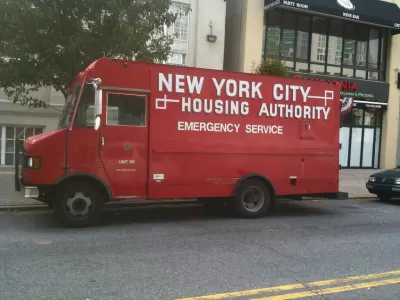Housing advocates blame the neglect of the federal government on the state of public housing in the United States. The Trump administration says government can't keep throwing money at the problems of public housing.

Pam Fessler continues NPR's coverage of the Trump administration's funding of public housing, especially with the fund that pays for repairs to aging public housing facilities around the country.
Public housing officials estimate that it would cost $50 billion to fix living for the 2 million Americans currently living in public housing. "Part of the problem stems from a steady decline in public housing repair funding over the past decade. About $2 billion to $3 billion has been appropriated in recent years, half the amount approved in 2000. At the same time, the needs have grown at a more rapid rate, creating a massive backlog," according to Fessler.
According to previous coverage by Fessler from April 2019 (and Planetizen coverage from March 2019), the Trump administration's draft budget for 2020 proposing cuts to public housing repair funding in addition to eliminating the HOME program and Community Development Block Grants.
Fessler's current coverage reports on the Trump administration's support of the cuts, as explained in recent statement by U.S. Department of Housing and Urban Development Ben Carson to a House appropriations subcommittee, but the bulk of the article is devoted to describing living conditions in public housing units around the country.
FULL STORY: Trump Administration Wants To Cut Funding For Public Housing Repairs

Alabama: Trump Terminates Settlements for Black Communities Harmed By Raw Sewage
Trump deemed the landmark civil rights agreement “illegal DEI and environmental justice policy.”

Planetizen Federal Action Tracker
A weekly monitor of how Trump’s orders and actions are impacting planners and planning in America.

The 120 Year Old Tiny Home Villages That Sheltered San Francisco’s Earthquake Refugees
More than a century ago, San Francisco mobilized to house thousands of residents displaced by the 1906 earthquake. Could their strategy offer a model for the present?

Indy Neighborhood Group Builds Temporary Multi-Use Path
Community members, aided in part by funding from the city, repurposed a vehicle lane to create a protected bike and pedestrian path for the summer season.

Congestion Pricing Drops Holland Tunnel Delays by 65 Percent
New York City’s contentious tolling program has yielded improved traffic and roughly $100 million in revenue for the MTA.

In Both Crashes and Crime, Public Transportation is Far Safer than Driving
Contrary to popular assumptions, public transportation has far lower crash and crime rates than automobile travel. For safer communities, improve and encourage transit travel.
Urban Design for Planners 1: Software Tools
This six-course series explores essential urban design concepts using open source software and equips planners with the tools they need to participate fully in the urban design process.
Planning for Universal Design
Learn the tools for implementing Universal Design in planning regulations.
Clanton & Associates, Inc.
Jessamine County Fiscal Court
Institute for Housing and Urban Development Studies (IHS)
City of Grandview
Harvard GSD Executive Education
Toledo-Lucas County Plan Commissions
Salt Lake City
NYU Wagner Graduate School of Public Service





























